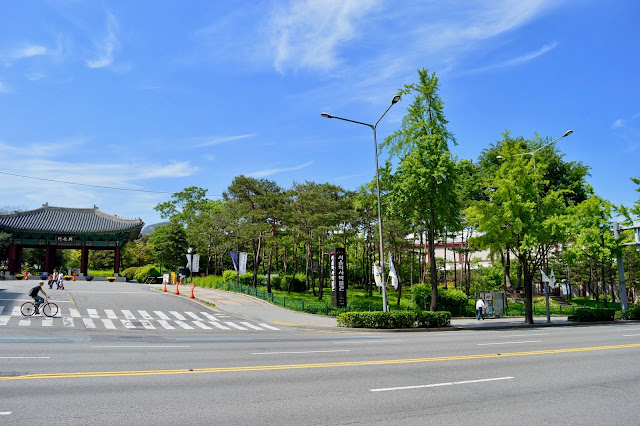A trip through Asia wouldn't be whole without passing by the vibrant city of Seoul. While recognised as a metropolis for young people and new technology concepts, it is also a city with a past. My tour started at the Seoul Plaza, where Seoul's City Hall and the famous Deoksugung Palace are located. At the corner of Seoul's busiest downtown intersection, the Deoksugung Palace is famous for its elegant stone-wall road and a series of Roman-styled buildings that add to the singularity of the surrounding architecture and landscape. Several details, like the small animal statues in the ceiling, can be found all over the ancient Korean-styled houses. For that kind of detailed information, you can get outside the complex free tours organised by young students, that only wish to practice some english and help visitors. Installed behind the palace complex and along the wall, there are tiny compact sculptures whose author or purpose I don't know. A bit further west is the Gyeonghuigung Palace. From there I walked all the way north in direction of the Gyeongbokgung Palace, which is located at the end of the long avenue Sejong-Daero. Also with guided tours available, this 14th-century royal palace was the main palace of the Joseon dynasty and the largest of the five Grand Palaces built at that time. With its surrounding gardens, ponds, statues and even a museum, it occupies a large surface in the north part of the city and is regarded as one of the most beautiful palaces. At the time the Royal Culture Festival was running for ten days and fortunately I was able to participate in the celebrations. The Bukchon Hanok Village is right on the northeast corner of the palace, surrounded by Gyeongbokgung Palace, Changdeokgung Palace and Jongmyo Shrine, and is home to hundreds of traditional houses called Hanok. The preserved 600-year-old urban environment is composed by many up-and-down-the-hill alleys, the Hanok houses and is now used as a popular cultural centre for old Seoul, having also cafés, restaurants and shops in its scope. Another lucky moment for me, the Lantern Festival - or Buddha's birthday celebration - was taking place not that far away and only occurs on the 8th day of the 4th lunar month. The Jogyesa Temple got fully dressed with diverse luminous coloured lanterns, awaiting the 2 and half hours long parade that started at the Dongdaemun Gate.
For more information:










































Comments
Post a Comment